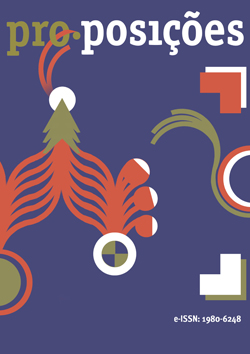Resumen
En este artículo, investigamos el pensamiento computacional de los estudiantes de educación matemática. Específicamente, a través del análisis de experimentos de enseñanza realizados como estudios de caso cualitativos, exploramos aspectos del construccionismo y la resolución de problemas. En diferentes escenarios de aprendizaje, parejas de estudiantes de primaria y de pregrado exploraron problemas de codificación para completar una tarea matemático-computacional. Desde un punto de vista construccionista, los resultados indican que la experiencia de aprendizaje implicó una espiral de descripción, ejecución, reflexión y depuración de problemas. En el caso de la experiencia de los estudiantes de pregrado, también identificamos características específicas del pensamiento computacional relacionadas con los procesos heurísticos, como la exploración, planificación, análisis y verificación.
Citas
Artigue, M., & Mariotti, M. A. (2014). Networking theoretical frames: the ReMath enterprise. Educational Studies in Mathematics, 85(3), 329-355.
Bikner-Ahsbahs, A. (2010). Networking of theories: why and how? In V. Durand-Guerrier, S. Soury-Lavergne, & F. Arzarello (Eds.), Proceedings of the Sixth Congress of the European Society for Research in Mathematics Education (pp. 6-15). Institut National de Recherche Pédagogique, Paris.
Bikner-Ahsbahs, A., Prediger, S. (2010). Networking of theories: an approach for exploiting the diversity of theoretical approaches. In B. Sriraman, & L. English (Eds.), Theories of mathematics education: seeking new frontiers (pp. 483-506). Berlin: Springer.
Borba, M. C., & Villarreal, M. E. (2005). Humans-with-media and the reorganization of mathematical thinking: information and communication technologies, modeling, visualization and experimentation. New York: Springer.
Denning, P. J. (2017) Remaining trouble spots with computational thinking. Communications of the ACM, 60(6), 33-39.
Gadanidis, G. (2015). Young children, mathematics, and coding: a low floor, high ceiling, wide walls environment. In D. Polly (Ed.), Cases on technology integration in mathematics education (pp. 308-329). Hershey: IGI Global. doi:10.4018/978-1-4666-6497-5.ch015
Gadanidis, G., & Yiu, C. (2017). Repeating patterns + code + art. Math surprise: conceptual, emotional, engaging. Retrieved from http://researchideas.ca/patterns/
Idem, R. C. (2017). Construcionismo, conhecimentos docentes e GeoGebra: uma experiência envolvendo licenciandos em matemática e professores. Masters’ Thesis, Universidade Estadual Paulista, Rio Claro.
Lu, J. J., & Fletcher, G. H. L. (2009). Thinking about computational thinking. ACM SIGCSE Bulletin, 41(1), 260-264.
Maltempi, M. V. (2005). Novas tecnologias e construção de conhecimento: reflexões e perspectivas. In Anais do V Congresso Ibero-americano de Educação Matemática. Associação de Professores de Matemática de Portugal, Porto.
Marshall, M. N. (1996). Sampling for qualitative research. Family Practice, 13(6), 522-526. Ontario Ministry of Education. (2005). The Ontario curriculum grades 1-8: mathematics. Retrieved from www.edu.gov.on.ca/eng/curriculum/elementary/math18curr.pdf
Papert, S. (1980). Mindstorms: children, computers, and powerful ideas. New York: Basic Books. Papert, S. (1993). The children’s machine: rethinking school in the age of the computer. New York: Basic Books.
Polya, G. (1957). How to solve it: a new aspect of mathematical method (2a ed.). Garden City: Doubleday Anchor.
Powell, A. B., Francisco, J. M., & Maher, C. A. (2003). An analytical model for studying the development of learners’ mathematical ideas and reasoning using videotape data. Journal of Mathematical Behavior, 22(4), 405–435.
Schoenfeld, A. H. (1985). Mathematical problem solving. New York: Academic Press.
Schoenfeld, A. H. (1992). Learning to think mathematically: problem solving, metacognition, and sense-making in mathematics. In D. Grouws (Ed.), Handbook for research on mathematics teaching and learning (pp. 334-370). New York: MacMillan.
Stake, R. E. (2000). Case studies. In N. K. Denzin, & Y. S. Lincoln (Eds.), Handbook of qualitative research (2a ed., pp. 435-453). Thousand Oaks: Sage.
Steffe, L. P., & Thompson, P. W. (2000). Teaching experiment methodology: underlying principles and essential elements. In R. Lesh, & A. E. Kelly (Eds.), Research design in mathematics and science education (pp. 267-307). Hillsdale: Erlbaum.
Tall, D. (1991). The psychology of advanced mathematical thinking. In D. Tall (Ed.), Advanced mathematical thinking (pp. 3-21). Dordrecht: Springer.
Valente J. A. (2003). In service teacher development using ICT: first step in lifelong learning. In C. Dowling, & K.-W. Lai (Eds.), Information and communication technology and the teacher of the future (pp. 97-108). Boston: Springer.
Wilkerson, M. H., Andrews, C., Shaban, Y., Laina, V., & Gravel, B. E. (2016). What’s the technology for? Teacher attention and pedagogical goals in a modeling-focused professional development workshop. Journal of Science Teacher Education, 27(1), 11-33.
Wing, J. M. (2006) Computational thinking. Communications of the ACM, 49(3), 33-35.
Wing, J. M. (2008). Computational thinking and thinking about computing. Philosophical Transactions of the Royal Society A: Mathematical, Physical and Engineering Sciences, 366(1881), 3717-3725

Esta obra está bajo una licencia internacional Creative Commons Atribución 4.0.
Derechos de autor 2020 Pró-Posições


